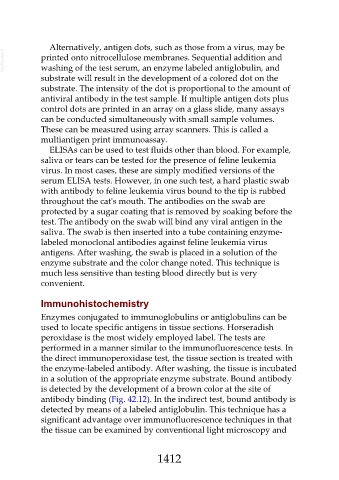Page 1412 - Veterinary Immunology, 10th Edition
P. 1412
Alternatively, antigen dots, such as those from a virus, may be
VetBooks.ir printed onto nitrocellulose membranes. Sequential addition and
washing of the test serum, an enzyme labeled antiglobulin, and
substrate will result in the development of a colored dot on the
substrate. The intensity of the dot is proportional to the amount of
antiviral antibody in the test sample. If multiple antigen dots plus
control dots are printed in an array on a glass slide, many assays
can be conducted simultaneously with small sample volumes.
These can be measured using array scanners. This is called a
multiantigen print immunoassay.
ELISAs can be used to test fluids other than blood. For example,
saliva or tears can be tested for the presence of feline leukemia
virus. In most cases, these are simply modified versions of the
serum ELISA tests. However, in one such test, a hard plastic swab
with antibody to feline leukemia virus bound to the tip is rubbed
throughout the cat's mouth. The antibodies on the swab are
protected by a sugar coating that is removed by soaking before the
test. The antibody on the swab will bind any viral antigen in the
saliva. The swab is then inserted into a tube containing enzyme-
labeled monoclonal antibodies against feline leukemia virus
antigens. After washing, the swab is placed in a solution of the
enzyme substrate and the color change noted. This technique is
much less sensitive than testing blood directly but is very
convenient.
Immunohistochemistry
Enzymes conjugated to immunoglobulins or antiglobulins can be
used to locate specific antigens in tissue sections. Horseradish
peroxidase is the most widely employed label. The tests are
performed in a manner similar to the immunofluorescence tests. In
the direct immunoperoxidase test, the tissue section is treated with
the enzyme-labeled antibody. After washing, the tissue is incubated
in a solution of the appropriate enzyme substrate. Bound antibody
is detected by the development of a brown color at the site of
antibody binding (Fig. 42.12). In the indirect test, bound antibody is
detected by means of a labeled antiglobulin. This technique has a
significant advantage over immunofluorescence techniques in that
the tissue can be examined by conventional light microscopy and
1412

